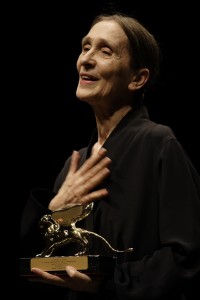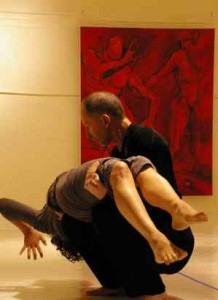She made dance theater out of life
MERILYN JACKSON
While millions routinely mourn the death of burnt-out pop stars, the death of an artistic genius at her peak at 68 goes largely unremarked in these United States.
Josephine (Pina) Bausch, who died of cancer June 3o, 2009 at 68, was to dance what Brecht was to acting, Wagner was to opera, and Dali to painting. She changed our perception of ballet, of modern dance and of theater. In the nearly 40 years since she became artistic director of Germany’s Tanztheater Wuppertal, Bausch made dance into theater in two to three hour-long evenings. People who sat the same length of time for a play complained her programs were too long. But those are people who need to be told, not shown, who need to look, not see.
Whether in Japan (where she was awarded the 2007 Kyoto Prize for arts and philosophy) or in Italy (where she received the Golden Lion at the Venice Biennale, also in 2007), Bausch was treated like a rock star. Her death was front-page news in Europe’s major newspapers.
Pina traveled the world making dances. Wherever she went, she soaked up the essences of a community and then, as the best artist should, held what she absorbed back up to it like a mirror. In Turkey in 2003 she created Nefes, whose semi-erotic scenes drew us into a dream world that stays in our memory as if we’d been born in Constantinople.
An Arizona interview
In 1996, she made Nur Du (“Only You”) in collaboration with four universities, including Arizona State University in Tempe. And that’s how I had my magical morning with her.
I had flown in to Phoenix on an early October day to interview Pina for an advance story for the Phoenix New Times. I was nervous to meet this woman with her martyred, saintly serene face– and her formidable reputation for being remote and unapproachable.
Before my flight, I went to a farmer’s market and spied some beautiful Dinosaur Egg plums, striated in creamy white and purple. I bought two dozen, thinking to make a gift for Pina and her entourage. Directly from the plane, I met her in a most unlikely place: a desert golf resort in Tempe.
Here, strapping tow-headed dudes in chaps and red neckerchiefs served barbecue and beans to our highly amused group seated at a wood plank table. Sawdust covered the rough-hewn floors. The lighting was basement rec room.
Breaking the ice
After being introduced, I sat tongue-tied for a few moments. Then I remembered the delicate plums I had carried on the plane with me that morning. I withdrew one from the sack and held it out in my palm. Pina’s hands fluttered to her chest as she cried, “For me?”
The ice broken, I asked Pina what she knew about the Southwest. “Really, not very much,” she replied. “I am here to learn.”
“Oh,” I asked, jumping in feet first, “would you like to see a Yaqui Indian town where packs of dogs roam free in the dust, gaunt and taut as your dancers? Where the Yaqui dance their Easter Deer dances? Where they dance the rosary?”
Bausch met each question with the Garbo-esque flutter of hands across her chest. “Really?” “Could I?” “Where?”
“It’s right down there,” I pointed to a spot in the distance. “We could see the Yaqui Temple tomorrow morning if you like.”
“So close?” she asked, drawing out her vowel.
More than anything, I wanted Bausch to see the inside of the temple where the townspeople keep icons of the Virgin of Guadalupe. I knew that her new work, as inexplicably as anything else in her vast oeuvre, would have an icon of the Virgin– but with the face of a man.
‘I too am a dancer’
The following morning, when we pulled up at 10:30, the temple doors miraculously yawned open to the sight of lit candles colonnaded along the dirt floor.
Adjusting our eyes to the dark interior, we noticed that a local resident had followed us in. I introduced Pina to him, explaining that she was a dancer from Germany.
“I too am a dancer,” he announced defiantly, training his Peyote-red eyes on ours. “I am Richard A. Valencia, head of the Matachini Yaqui dancers. I have 12 dancers. How many do you have?”
Pina’s hands crossed her chest and she bowed slightly, tipping her head as if to meet his height, “I have 28,” she answered apologetically.
Valencia received this information stoically. After Pina gave him a donation to the temple’s new roof fund and invited him and his dancers to her show, we crossed over to DeLeon’s Western Wear, chatting about our kids— she had one son, still in his teens at the time.
At DeLeon’s, a shop crammed with western wear and turista trinkets, Pina spied a basket of Mexican paper flowers and wanted to take some. She had difficulty choosing quickly from the vast palette of colors, so Guillermo DeLeon, a tall, striking man, gallantly flung hundreds of flowers at her feet. Kneeling among them, she picked the colors she wanted.
A journey with stops along the way
A few years later, the Wuppertal Tanztheater returned to Tempe to perform one of Pina’s most infamous pieces, Carnations (Nelken, in German), where the stage is studded with thousands of pink carnations, and four gaunt black mastiffs handled by brawny trainers roam among the dancers.
The day after the performance, most of the troupe had gone up to the Grand Canyon, leaving behind the veteran dancer Dominique Mercy, a Wuppertaler for more than 28 years and one of the world’s most brilliant comedic dancers. He asked if there was a place to swim. I drove him up to Canyon Lake. After his swim we ate pâté and what passes for French bread in Arizona that I had brought along. I told him about the dogs running wild in Guadalupe, the incident with DeLeon and how the carpet of paper flowers he threw out around Pina had reminded me of Carnations.
“Nelken is like that,” Mercy said. “Like going through a little journey with little stops along the way. We make theater out of life.” Yes, wherever Pina ventured, dance and theater happened.♦
This originally appeared in Broad Street Review, June, 2009

